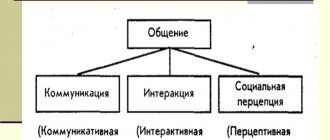Modern society cannot function normally without people interacting with each other. Each personality is individual, but, undoubtedly, it is believed that it must adapt to different situations. This allows a person to find a job, a partner, or go on a trip. A person’s manner of communication and behavior is formed throughout his life. They may change, be supplemented with other techniques, and any one type may be lost. Factors and reasons are very different. There is only one goal: to achieve results. Through communication, a person can achieve a lot; you just need to choose the right style of communication and behavior.
Communication styles
Communication style is characterized by a habitual, stable connection between the methods and methods of communication and the goals it pursues. That is, these are some features of interaction between people. A person is looking for a new job, comes for an interview - here he uses one style of communication, when interacting with colleagues - another, in the family and in communicating with relatives - a third. Different communication styles are chosen for each specific situation. No matter what action is taken, a person's words will always be the basis of communication.
Combination of different styles in education
Educators and psychologists have long come to the conclusion that it is almost impossible to adhere to only one style, since situations are different and require different influences. In reality, parents have to use elements from different styles, so we can safely talk about combining parenting styles.
The authoritarian-permissive style will be characterized by a balance between control and laissez-faire. But since both of these styles presuppose emotional coldness and distance in relationships, if they are mixed, the child will remain deprived of intimacy and trusting relationships.
If you combine the democratic and permissive style, then against the backdrop of partnership and trust, parental control may decrease. This is good in adolescence, but not advisable with young children.
Communication styles from a psychological point of view
Psychology has always dealt with problems of interaction between people. According to psychologists, communication style is determined by a person’s ability to choose certain means of behavior in a certain situation. They divided communication styles into three categories:
- flexible;
- rigid;
- transition.
With a flexible style, a person is well oriented in society, he can adequately assess who is in front of him, quickly understand what is being said, and even guess about the emotional state of the interlocutor. With a rigid style, a person cannot quickly analyze not only his own behavior, but also the behavior of his interlocutor. He has poor self-control and cannot always choose the appropriate way of behavior and communication. With a transitional style, a person has signs from the two above-mentioned styles. He does not fully understand what is happening around him, with whom he communicates and what method of interaction is best to choose.
Exploring Communication Styles
When studying communication techniques, you need to know that the style of communication in itself and the style of communication in any situation are different concepts. If you do not take into account the characteristics of a person’s character and the characteristics of the situation in which he finds himself, then the explanation will simply be meaningless. There are a large number of methods for studying communication styles. For example, A.V. Petrovsky created a system of pedagogical interaction consisting of two components. It was called the style of pedagogical communication.
In 1938, attention was paid to communication styles for the first time. German psychologist Kurt Lewin conducted a study and developed a classification of relationships between people who manage and people who are forced to obey. Subsequently, it became generally accepted and is still in effect. His teaching communication styles include:
- authoritarian;
- democratic;
- liberal.
Article:
One of the factors influencing the development of a child’s personality is the communication style inherent in the teacher.
The style of pedagogical leadership can be defined as methods of educational influence, manifested in a typical set of requirements and expectations for the appropriate behavior of students. It is embodied in characteristic forms of organizing the activities and communication of children and has appropriate ways of implementing the teacher’s attitude towards the child’s personality, associated with the achieved level of professional and pedagogical activity. Traditionally, democratic, authoritarian and liberal styles are distinguished.
Democratic style of communication
The democratic style of interaction is considered the most effective and optimal. It is characterized by broad contact with pupils, the manifestation of trust and respect for them, the teacher strives to establish emotional contact with the child, and does not suppress with severity and punishment; Positive assessments predominate in interactions with children. A democratic teacher feels the need for feedback from children on how they perceive certain forms of joint activity; knows how to admit mistakes made. In his work, such a teacher stimulates mental activity and motivation to achieve cognitive activity. In groups of educators whose communication is characterized by democratic tendencies, optimal conditions are created for the formation of children's relationships and a positive emotional climate of the group. The democratic style ensures friendly mutual understanding between teacher and student, evokes positive emotions and self-confidence in children, and gives an understanding of the value of cooperation in joint activities.
Authoritarian communication style
Teachers with an authoritarian communication style, on the contrary, display pronounced attitudes and selectivity towards children, they are much more likely to use prohibitions and restrictions in relation to children, and abuse negative assessments; severity and punishment are the main pedagogical means. An authoritarian educator expects only obedience; it is distinguished by a large number of educational influences with their uniformity. A teacher’s communication with authoritarian tendencies leads to conflict and hostility in children’s relationships, thereby creating unfavorable conditions for the upbringing of preschoolers. The teacher’s authoritarianism is often a consequence of an insufficient level of psychological culture, on the one hand, and a desire to accelerate the pace of children’s development, despite their individual characteristics, on the other. Moreover, teachers resort to authoritarian methods with the best intentions: they are convinced that by breaking children and achieving maximum results from them here and now, they can more quickly achieve their desired goals. A pronounced authoritarian style puts the teacher in a position of alienation from the students; every child experiences a state of insecurity and anxiety, tension and self-doubt. This happens because such teachers, underestimating the development of such qualities in children as initiative and independence, exaggerate their qualities such as indiscipline, laziness and irresponsibility.
Liberal communication style
A liberal educator is characterized by lack of initiative, irresponsibility, inconsistency in decisions and actions, and indecisiveness in difficult situations. Such a teacher “forgets” about his previous requirements and, after a certain time, is able to present completely opposite requirements to the requirements he himself had previously given. Tends to let things take their course and overestimate the capabilities of children. Does not check whether its requirements are met. A liberal teacher's assessment of children depends on their mood: in a good mood, positive assessments predominate, and in a bad mood, negative assessments predominate. All this can lead to a decline in the authority of the teacher in the eyes of children. However, such a teacher strives not to spoil relations with anyone; his behavior is affectionate and friendly with everyone. She perceives her students as proactive, independent, sociable, and truthful.
The style of pedagogical communication as one of the characteristics of a person is not an innate (biologically predetermined) quality, but is formed and cultivated in the process of practice on the basis of the teacher’s deep awareness of the basic laws of development and formation of a system of human relations. However, certain personal characteristics predispose to the formation of a particular communication style. For example, people who are self-confident, proud, unbalanced and aggressive tend to have an authoritarian style. The democratic style is predisposed by such personality traits as adequate self-esteem, balance, goodwill, sensitivity and attentiveness to people.
Research has shown that after the departure of an “autocrat” teacher, it is not recommended to appoint a “liberal” to the group, but after a “liberal”, an “autocrat” is possible. A “Democrat” can be appointed after any predecessor.
In life, each of the named styles of pedagogical communication in its “pure” form is rarely encountered. In practice, it is often found that an individual teacher exhibits a so-called “mixed style” of interaction with children. A mixed style is characterized by the predominance of two styles: authoritarian and democratic or democratic style with inconsistent (liberal). The features of authoritarian and liberal styles are rarely combined with each other.
Characteristics of pedagogical communication styles
Pedagogical communication styles were defined as emotional techniques and actions of the teacher in relation to the student. The teacher's behavior is determined by his understanding of the goal that he pursues in teaching the child. Most often, this is nothing more than teaching a child the basics of his subject, transferring skills that the student will need to complete a task, or that will be useful to him in later life. At the same time, the teacher also takes into account the child’s communication styles. Communication with children is completely different from that with adults. The teacher needs a little more time, effort and attention to explain the material to the child. Communication itself occurs through instructions, explanations, questions, comments and even prohibitions.
How to behave in a new team
Psychology of communication - how to learn to talk to people correctly
The strategy of behavior in a new team depends on the position held. If a school director may exhibit more authoritarian qualities, on the part of an ordinary employee such behavior may look like an abuse of authority.
Another example is a teacher and his assistant in a preschool educational institution. A teacher cannot only be a “democrat”; without authoritarian qualities, he risks shaking discipline in the group. A helper who is not involved in the children's teaching may adopt a liberal or neutral demeanor.
Beginning teachers have difficulty choosing a communication style; the most common mistake is lack of maneuverability. Often a young teacher chooses for himself the role of a “democrat” or a leader and does not deviate one step from it.
New teacher
When choosing pedagogical communication styles for yourself in a new team, you need to take a closer look at the students. To be sure, you can attend a class session with another teacher to assess children's behavior and develop your own strategy. If this is not possible, you need to conduct a short introductory lesson where you can communicate with your students and draw conclusions.
Learning is a complex technological process that largely depends on the teacher’s ability to convey information to students. The most productive type of communication is considered to be a mixed one, in which you can combine the best qualities and smooth out the shortcomings. Over time, each teacher develops an individual teaching style that he constantly uses.
Authoritarian communication style
An authoritarian style of communication implies that the teacher reserves the right to resolve issues independently. They can concern relationships between students, activities in the classroom, or concern each student personally. As a rule, such a regime includes both dictatorship and concern for subordinates. With such teachers, students can rarely open up fully and show their capabilities. Initiative can cause conflict between teacher and student. The teacher’s belief that only his thinking is correct and everything else is false does not allow both parties to interact productively. The child's answer cannot be adequately assessed because the teacher simply does not understand the student and is based only on performance indicators. His bad actions always come to the fore in the eyes of the teacher, while the motives for his behavior are not taken into account.
The importance of choosing the type of communication between the teacher and students
The choice of communication strategy depends on the following factors:
- Characteristics of the audience: age of the students, predominance of boys or girls in the class;
- Tasks that are set for the teacher;
- Characteristics of the teacher: phlegmatic or hot-tempered;
- Rules of communication that were previously established in the team. Some school and preschool educational institutions have their own behavioral systems, from which it is prohibited to deviate.
Types of communication in psychology - what they include, its functions
The atmosphere in the team and the students’ disposition towards the teacher and his subject depend on the chosen style. As practice shows, authoritarian behavior, which was previously the most common, is today unacceptable to be used in its pure form.
The pedagogy of past generations was based on the principle of student management, the transfer of knowledge was the main task. What is more important now is how much the child knows how to use this knowledge in real life. We can say that democratic and mixed communication styles are becoming increasingly popular.
Important information! When moving from junior to senior grades, teachers change, so it is important to pay attention to the choice of a new class teacher. After a liberal teacher, you cannot appoint an authoritarian one and vice versa. At the same time, a “democrat” is allowed to be installed in the place of the class leader, regardless of his predecessors.
Democratic style of communication
The democratic style of communication is considered the best, because the teacher strives to help the student, use all his strengths and capabilities, and activate the child’s role in the life of the class. Interaction and collaboration are the main goals of this style. The teacher evaluates, first of all, the good actions of the student, treats him well, understands him and supports him. If the teacher sees that the child does not have time to assimilate information or does not understand something, then he will definitely slow down the pace and explain the material more carefully, putting everything in order. The teacher adequately assesses the student’s capabilities and can predict the direction of his development. He takes into account the interests and wishes of his students. Some methods of teaching and communicating with students of teachers of the democratic style are slightly inferior to the methods of the authoritarian style of their colleagues, but the “climate” in the classroom is still better for the former. Children feel much freer.
Liberal communication style
The teaching styles of a liberal style teacher differ from those included in other teacher communication styles. He strives to reduce all chances of taking any part in the life of the class, and does not want to bear responsibility for the students. The teacher is limited to performing exclusively his pedagogical functions. The teacher's communication styles that he combines in his work lead to poor academic performance. He is somewhat indifferent to the problems of both the school and the children, as a result of which it is very difficult for him to control the students.
Characteristics of business communication styles
Business communication styles imply any actions or methods of communication aimed at achieving any result. In this case, the main task of those participating in the conversation becomes to reinforce the idea of themselves as a member of the team or society as a whole. The participant, as it were, puts on his festive mask and becomes a different person for a while. This peculiar ritual, on the one hand, sometimes seems meaningless and boring, but on the other hand, it is a game, the rules of which a person knows in advance and must follow.
Ritual style of communication
Business communication styles like ritual are often used in companies whose members have known each other for a long time. And so they meet, spend some time together, and it seems that after these years the topics discussed in these companies do not change at all. Sometimes you can even predict what one or another participant in the conversation will say, but, nevertheless, everyone is happy with everything and after the day, some even feel satisfied with the time spent. This style of communication is considered a typical case of a ritual style, where the quality of communication comes to the fore, and not its content. Thus, the same reinforcement of the idea of oneself as a member of a team occurs, where everyone occupies some place, everyone is important. His opinions, values, and worldview are important.
Cases when a person who, when asked: “How are you?” always answers unequivocally: “Fine,” and now suddenly begins to tell a detailed story about his life, family, children and work, which is called going beyond the ritual. Such atypical behavior of a person, whose reaction could always be guessed, violates the idea of ritual, because the main thing is to wear a mask, be it in social relationships or interpersonal ones.
Manipulative communication style
With this style of communication, a person is perceived by others as a means to an end. As a rule, the interlocutor tries to show the best aspects of his goal so that he can help him achieve it. Despite the fact that both participants in the conversation have different ideas about the component of this goal, the one who is more skillful in the methods of manipulation will win. In such cases, the interlocutor knows about the reasons for the partner’s behavior, about his aspirations, desires, and can turn the development of events in the direction he needs. Manipulation is not necessarily a bad method. Many goals are achieved this way. Sometimes, in order to convince a person to do something, to force him to act, it is necessary to resort to a manipulative communication style.
This can be compared to the communication method of a middle manager. He speaks in one tone with his superiors, but with his subordinates in a completely different tone. Sometimes it is unpleasant, but there is no other way.
There are cases when a person’s entire communication style comes down to manipulation. Due to the too frequent use of this method on a person, his constant persuasion and pushing, the latter may consider manipulation the only correct way out of the situation.
Conversational style
Communication styles will also include conversational and everyday styles in their list. It is characterized by informal relationships that are connected not only with everyday life, family, circle of friends, but also with the professional environment. Conversational language is used in interpersonal communication. It is because of this that its manifestation in most cases takes an oral form during spontaneous dialogues. Pre-thinking what is said during such a conversation is not always acceptable.
Colloquial speech is also used for self-expression; with its help, the individual’s individual abilities are manifested, since it has an emotional connotation.
A large role here is given to non-verbal means of interaction and expressive signals of the body. Informal communication has also found wide application in everyday vocabulary:
- Vernacular.
- Words that have a subjective assessment.
- Expressive and emotional statements.
- In the form of abbreviations.
- In the form of colloquial and everyday phraseology.
- Variety of particles, etc.
The use of exclamatory and incentive sentences is also widely practiced. This style of speech is used only in some specific cases.
Humanistic style of communication
With the humanistic style of communication, we are talking about interpersonal relationships in which a person wants to be understood, supported, given advice, to be empathized with. Initially, this type of communication does not imply any goal; the situation consists of ongoing events. This style of communication can be called the most sincere of all existing ones, where those very events are intimate, confessional in nature. The main method that works here is suggestion, and mutual. Each partner inspires the other that he is worthy of trust, that one is ready to listen, and the other is ready to tell what worries him.
Such communication can occur not only between loved ones and relatives. For example, in a few tens of minutes a person can recognize the interlocutor who is traveling with him on the bus in the next seat or tell him a lot about himself, but he does not know the person with whom he has been working for several years. A conversation with a fellow traveler leads to some revelations about oneself, makes people feel each other, and empathize. But a conversation with a colleague has completely different goals.
Which parenting style is best?
This question is almost impossible to answer because every parent and child is different. Each family is individual, so it is necessary to create an individual parenting style that will be both stable and capable of development and improvement.
Undoubtedly, parenting requires a lot of time and effort from parents. But looking at their healthy, happy and successful child, no parent will regret the energy expended. After all, the dream of any parent is for their child to be a full-fledged person.









